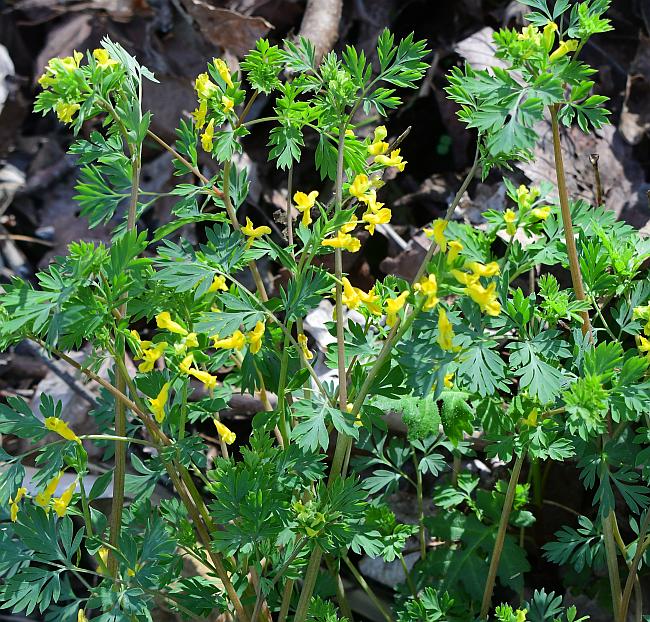Corydalis flavula (Raf.) DC.
Pale Corydalis

Native
CC = 3
CW = 3
MOC = 68
© SRTurner
Corydalis flavula (Raf.) DC.Pale Corydalis | |
 |
Native CC = 3 CW = 3 MOC = 68 |
© SRTurner |
|
Family - Fumariaceae Habit - Annual, occasionally biennial, taprooted forb.
Stems - Loosely ascending, to 30 cm, branched and sometimes multiple, from a spreading base, glabrous, glaucous, often reddish.
Leaves - Basal and alternate, the lower leaves with the petiole 4-8 cm long, the upper leaves usually sessile. Leaf blades 2 or 3 times compound and lobed, 1-4 cm long, with 5 or 7 pinnae, these deeply several-lobed, the ultimate segments linear to narrowly oblong or less commonly broadly elliptic, mostly sharply pointed at the tip, green or pale and glaucous.
Inflorescence - Racemes, to 8cm long, mostly not extending past the foliage, those with open flowers 6-12-flowered racemes, those with cleistogamous flowers 1-5-flowered clusters. Flower stalks (except sometimes in cleistogamous flowers) 9-22 mm long, ascending at flowering, often pendent at fruiting, subtended by leaflike bracts, these to 1 cm long, 7 mm broad, acute.
Flowers - Sepals 1-2 mm long, ovate to ovate-triangular, membranous and white to pale yellow. Corollas bilaterally symmetrical, yellow, the upper outer petal 7-9 mm long, the spur (except in cleistogamous flowers) 1.5-2.0 mm long, slightly curved downward, the concave apical portion usually with an irregular, wavy or toothed crest. Petals 4, unequal, slightly joined at base, glabrous. Inner 2 petals connate around the 6 stamens. Stamens diadelphous. Style persistent, slender to relatively stout, the stigma 2-lobed, flattened and somewhat fan-shaped, with 4 or more commonly 8 winglike papillae.
Fruit - Capsules 14-25 mm long, relatively straight, glabrous. Seeds 1.9-2.1 mm long, the surface finely pebbled, the sharply angled rim with a minute marginal ridge. Flowering - April - May. Habitat - Bottomland forests, ravines, bases of bluffs, streambanks, shaded roadsides, railroads. Origin - Native to the U.S. Lookalikes - Several other species of Corydalis. The foliage is similar to that of Dicentra. Other info. - This delicate and inconspicuous species is one of Missouri's springtime ephermerals, blooming early and disappearing completely by mid-summer. It is found across most of Missouri, mostly commonly south of the Missouri River. Beyond Missouri it ranges mostly eastward, reaching the Atlantic coast and into New England. It is the most common member of the genus in Missouri. However, distinguishing the plant from its lookalikes can be challenging, requiring detailed examination of flower length, seed size, and seed surface texture. C. flavula has the smallest flowers and the longest flower stalks, and in addition the tip of the spur is incurved. Photographs taken at Eagle Bluffs Conservation Area, Boone County, MO., 3-27-04 (DETenaglia); also at Weldon Spring Conservation Area, St. Charles County, MO, 4-6-2011; near St. Albans, Franklin County, MO, 4-20-2014; and near Labadie, Franklin County, MO, 4-5-2021 (SRTurner). |